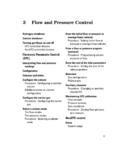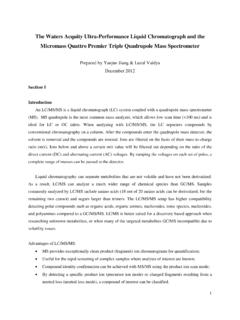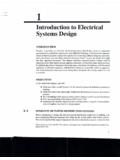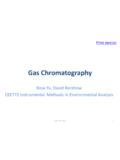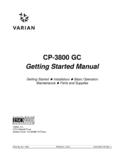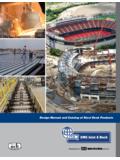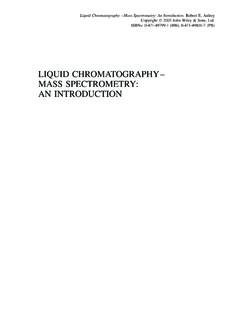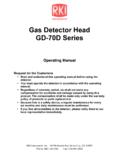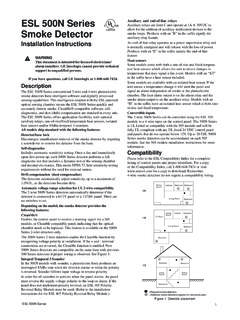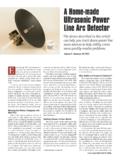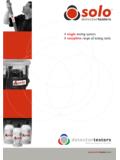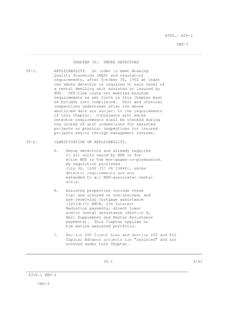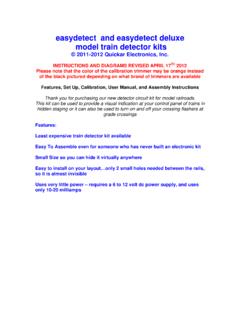Transcription of The Thermal Conductivity Detector - UMass Amherst
1 23 The Thermal Conductivity Detector General Information TCD pneumatics Conditions that prevent the Detector from operating Filament passivation Carrier, reference, and makeup gas Negative polarity Analyzing for hydrogen Operating the TCD. Columns and Traps Gas pressures Operating the TCD. Procedure: Using the TCD. Checkout Conditions and Chromatogram TCD checkout conditions Typical TCD checkout chromatogram Maintaining a Thermal Conduc- tivity Detector Correcting TCD performance problems Procedure: Thermal cleaning 549. Return to Contents The Thermal Conductivity Detector General Information The TCD compares the Thermal conductivities of two gas flows pure carrier gas (also called the reference gas) and carrier gas plus sample components (also called column effluent). This Detector contains a filament that is heated electrically so that it is hotter than the Detector body. The filament temperature is kept constant while alternate streams of reference gas and column effluent pass over it.
2 When sample is added, the power required to keep the filament temperature constant changes. The two gas streams are switched over the filament five times per second and the power differences are measured and recorded. When helium (or hydrogen) is used as carrier gas, the sample causes the Thermal Conductivity to fall. If nitrogen is used, the Thermal Conductivity usually goes up because most things are more conductive than nitrogen. Because the TCD does not destroy the sample during the detection process, this Detector can be hooked up in series to a flame ionization Detector or other Detector . 550. Return to Contents General Information The Thermal Conductivity Detector Vent Vent Reference Reference switching switching valve valve Makeup flow Makeup flow Column effluent diverted to bypass Column effluent diverted to filament channel. Filament surrounded by channel. If sample is present, Thermal reference gas. Conductivity rises or falls, depending on gas type.
3 Figure 76. TCD Conceptual diagram 551. Return to Contents General Information The Thermal Conductivity Detector TCD pneumatics TCD pneumatics Figure 77 shows the pneumatics design of the TCD. Vent Makeup and reference gas in Filter frit Reference switching Proportional Pressure valve valves sensors Restrictors PS. Pressure control loops Makeup flow PS. Figure 77. TCD pneumatics Conditions that prevent the Detector from operating Temperature set below 150 C. Broken or shorted filament Reference gas flow set to 0. 552. Return to Contents General Information The Thermal Conductivity Detector Filament passivation Filament passivation The tungsten-rhenium TCD filament has been chemically passivated to protect against oxygen damage. However, chemically active compounds such as acids and halogenated compounds may attack the filament. The immediate symptom is a permanent change in Detector sensitivity due to a change in filament resistance. If possible, such compounds should be avoided.
4 If this is not possible, the filament may have to be replaced frequently. Carrier, reference, and makeup gas Reference and makeup gas must be the same as the carrier gas, and the gas type must be specified in both the inlet and Detector control tables. When using packed columns, we recommend a small makeup gas flow (2 to 3 mL/min) to get the best peak shapes. Use Figure 78 to select a value for reference gas flow for either capillary or packed columns. Any ratio within of that in the figure is suitable. Ratio of reference flow to column + makeup flow 0. 10 20 30 40 50 60. Column + makeup flow, mL/min Figure 78. Selecting the reference gas flow 553. Return to Contents General Information The Thermal Conductivity Detector Negative polarity Negative polarity Sample components with higher Thermal conductivities than the carrier gas produce negative peaks. For example, helium or hydrogen form a negative peak with nitrogen or argon-methane as the carrier gas.
5 Neg polarity ON inverts the peak so the integrator or ChemStation can measure it. Neg polarity can be a run table entry; see Run time programming . Analyzing for hydrogen Hydrogen is the only element with Thermal Conductivity greater than helium, and mixtures of small amounts of hydrogen (<20%) in helium at moderate temperatures exhibit Thermal conductivities less than either component alone. If you are analyzing for hydrogen with helium carrier gas, a hydrogen peak may appear as positive, negative, or as a split peak. There are two solutions to this problem: Use nitrogen or argon-methane as carrier gas. This eliminates problems inherent with using helium as carrier, but causes reduced sensitivity to components other than hydrogen. Operate the Detector at higher temperatures from 200 C to 300 C. You can find the correct Detector operating temperature by analyzing a known range of hydrogen concentrations, increasing the operating temperature until the hydrogen peak exhibits normal shape and is always in the same direction (negative relative to normal response to air or propane) regardless of concentration.
6 This temperature also ensures high sensitivity and linear dynamic range. Because hydrogen peaks are negative, you must turn negative polarity on at appropriate times so the peak appears positive. 554. Return to Contents Operating the TCD The Thermal Conductivity Detector Analyzing for hydrogen Operating the TCD. Use the information in Table 62 when selecting temperatures and flows for the TCD. Use Figure 79 to locate minimum source pressures. If you have an EPC. Detector , you must add 10 psi (69kPa) to the source pressure on t he chart. Table 62. Recommended Flow Rates and Temperatures Gas type Flow range Carrier gas Packed, 10 to 60 mL/min (hydrogen, helium, nitrogen) Capillary, 1 to 5 mL/min Reference 15 to 60 mL/min (same gas type as carrier) See Figure 79 to select a value. Capillary makeup 5 to 15 mL/min capillary columns (same gas type as carrier) 2 to 3 mL/min packed columns Detector temperature <150 C, cannot turn on filament Detector temperature should be 30 C to 50 C greater than highest oven ramp temperature.
7 555. Return to Contents Operating the TCD The Thermal Conductivity Detector Gas pressures Gas pressures Choose a flow, find a pressure, set source pressure 10 psi (70 kPa) higher. 70. 60. Hydrogen Helium 50. Reference gas flow 40. Nitrogen (mL/min). 30. 20. 10. 0. Pressure (psig) 10 20 30 40 50 60. (kPa) 20. 18. 16. 14. Hydrogen 12. Makeup gas flow 10 Helium (mL/min) 9. Nitrogen 6. 4. 2. 0. Pressure (psig) 10 20 30 40 50 60. (kPa) Figure 79. Typical pressure/flow relationships, reference and makeup gases (at 25 C and 1 atmosphere of pressure). 556. Return to Contents Operating the TCD The Thermal Conductivity Detector Operating the TCD. Operating the TCD. Press [Front Det] or [Back Det]. Temperature C or off Reference gas flow, mL/min or off Turn off for packed columns.*. For capillary columns, see makeup gas flow mode below. Press [On] or [Off]. Shows output value Reverse polarity, turn on or off. See Instrument Automation . Makeup gas flow mode: If configured for capillary columns, your control table will also include one of these: To change makeup mode, scroll to Mode: and press [Mode/Type].
8 Make a selection and enter the appropriate flow values. To view makeup/reference gas, press To change makeup/reference gas, [Config][Front Det] or [Config][Back Det]: press [Mode/Type]: * A makeup flow of 2 to 3 mL/min improves peak shapes. Select the appropriate gas. Figure 80. TCD control table 557. Return to Contents Operating the TCD The Thermal Conductivity Detector Operating the TCD. Procedure: Using the TCD. This procedure assumes that Detector support gases are connected, the system is leak-free, and a column is installed. Before operating the Detector , set oven temperature, inlet temperature, and inlet/column flow. 1. Press [Front Det] or [Back Det] to open the Detector control table. 2. Set the Detector temperature. Do not set higher than the maximum temperature allowed for the column because part of the column passes through the heated block and into the cell. 3. Verify that gas type is the same as that plumbed to your instrument (next to Mkup line of control table).
9 Change the gas type, if necessary ( Makeup gas flow ). Caution Detector electronics depend on the correct gas type configuration. 4. Set the reference gas flow rate. 5. If you are using packed columns, turn off the makeup gas (or proceed to Step 6. and enter 2 to 3 mL/min, see Carrier, reference, and makeup gas ) and proceed to Step 7. 6. If you are using capillary columns: Short-cut a. If your column is defined and connected to an EPC inlet, choose a new flow procedure: mode ( Makeup gas flow ) if desired, and set the makeup gas flow or (assumes your setpoints are combined flow. stored). b. If your column is connected to a nonEPC inlet, enter a makeup gas flow. 1. Open Detector control table. Only constant flow is available in this case. 2. Turn temperature 7. Turn on the filament. Allow about 30 minutes for Thermal stabilization. A. On. longer period may be needed for the highest sensitivity. 3. Turn makeup gas On, if needed. 8. If necessary, turn Negative polarity [On] to invert negative-going peaks.
10 4. Press [Det Control] When a sample contains components giving both positive- and 5. Press [On]. negative-going peaks, Neg polarity can be switched on and off during a run as a timetable event. 558. Return to Contents Checkout Conditions and Chromatogram The Thermal Conductivity Detector TCD checkout conditions Checkout Conditions and Chromatogram This section contains a typical examples of a test sample chromatogram. It may be used as a general guide to instrument performance. Note that injection volumes listed with operating conditions do not necessarily indicate total absolute volume injected. Volume given is simply the graduation (plunger position) read from a standard 10 L syringe. For a heated inlet, actual sample volume injected will also include an additional L, the volume of sample volatilized from inside the syringe needle. For the dedicated, on-column inlet (unheated), the syringe plunger position more accurately reflects the true injected volume.
